Múa Lân Productions
ANIME CLASS
- took it Fall 2000
- Dr. Susan Napier
- Asian Studies
Department
- one of first anime classes
in the nation
|
|
I feel quite privileged and fortunate to have been able to take this class. An academic approach to anime was one
I had not been aware of, and I realized that anime itself could be even more meaningful than I thought. The papers
in this class were a pleasure to write, but I still wish I hadn't left them all until the morning-of to write them.
The Final Exam:
- take home essay
- open ended
ESSAY: "You're at a party talking with someone when you mention that you took a class on Japanese animation in college.
The other person remarks, 'How could the university offer a class on such garbage?! Besides, I hear that anime
is just all sex and violence anyway.' How do you respond?"
|
[ BACK TO MAIN ]
|
 |
[ BACK TO MAIN ]
The World of Japanese Animation: Final Exam
Nhan Nguyen: 12/11/00
"Well, you are certainly correct ... to a certain extent. Some Japanese animation is indeed
nothing more than sex and violence. You may have heard of an infamous series called Urotsuki: Legend
of the Overfiend; this particular title has been widely regarded as intensely offensive and shocking
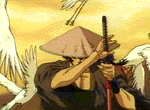 in its imagery. In fact it was banned in Europe, I believe. As for violence, you might have come
across bloody ninja/samurai titles, like the popular Ninja Scroll, that take animated violence beyond
anything you'd see made here in the US. So based on just this, I'd wholeheartedly agree with you.
If the university had offered a course structured only on these premises, I sure wouldn't take it.
in its imagery. In fact it was banned in Europe, I believe. As for violence, you might have come
across bloody ninja/samurai titles, like the popular Ninja Scroll, that take animated violence beyond
anything you'd see made here in the US. So based on just this, I'd wholeheartedly agree with you.
If the university had offered a course structured only on these premises, I sure wouldn't take it.
'Anime is just sex and violence,' right? Believe it or not, that's exactly what I thought
too. The only anime I had previously been exposed to was indeed filled with sex and violence. In
 a way, it was kind of cool (which is what many male teenagers would think, right?), but it still isn't
the kind of entertainment I'm interested in. One day, however, my younger brother rented this anime
called Ranma ½. I suddenly realized that Japanese animation wasn't all just R-rated material; here
was an anime (of the romantic comedy variety, which I wasn't even aware of) that was obviously for
children, but was just so fun and involving that I found myself entirely engrossed by it. I guess
that's when I first started liking anime.
a way, it was kind of cool (which is what many male teenagers would think, right?), but it still isn't
the kind of entertainment I'm interested in. One day, however, my younger brother rented this anime
called Ranma ½. I suddenly realized that Japanese animation wasn't all just R-rated material; here
was an anime (of the romantic comedy variety, which I wasn't even aware of) that was obviously for
children, but was just so fun and involving that I found myself entirely engrossed by it. I guess
that's when I first started liking anime.
But whenever anyone asked why I watched anime, I would say that I only watch this particular
title. I didn't want to say that I was an "anime fan" because that would then bring the direct
connotations with those sex and violence titles I had originally seen. There was no way I'd be
associated with that trash. I still liked Ranma and had found a few other good titles, but I still
wouldn't consider myself a "fan." Did you hear about that anime film that was shown in theaters
 awhile back? The title was Princess Mononoke. After reading on the internet how great this film was,
how it was the pinnacle of anime, etc, I took all my siblings and myself to see it. Although it was
a well done film, it wasn't exactly something I could even understand, much less like. And so I was
content with the few titles I had come to love, and decided that it would be enough. Then when I
found out that there was a class being taught at the university specifically on Japanese animation;
it was a class in the Asian Studies department. I decided to register. I had taken a few other
asian studies courses prior, which were all quite informative and interesting, so I figured I
might be able to learn something from this one ... and I certainly did.
awhile back? The title was Princess Mononoke. After reading on the internet how great this film was,
how it was the pinnacle of anime, etc, I took all my siblings and myself to see it. Although it was
a well done film, it wasn't exactly something I could even understand, much less like. And so I was
content with the few titles I had come to love, and decided that it would be enough. Then when I
found out that there was a class being taught at the university specifically on Japanese animation;
it was a class in the Asian Studies department. I decided to register. I had taken a few other
asian studies courses prior, which were all quite informative and interesting, so I figured I
might be able to learn something from this one ... and I certainly did.
The most important idea I took away from the course was an increased understanding and
appreciation for all types of anime. I learned that anime was an immensely large medium, that
had vast cultural and artistic ties both in Japan and universally. In calling it a medium, I am
suggesting that animation is simply another means by which a message is conveyed. That message
can be an involving story, or perhaps a psychological plethora of emotive imagery. In other words,
it is a medium in the same way that art, cinema, and music are mediums. Anime is so broad that it
encompasses all different genres, with sex/violence inevitably being an element in it. But by
categorizing all anime as mature-themed, we would be missing out on the vast majority of other
genres. Such a generalization would be comparable to looking at adult video, and thinking that
all cinema is as such. It's simply a problem of basing judgments from a limited, biased collection
of data. So those people who say anime is all sex and violence aren't necessarily wrong, as there
are such anime, they just aren't entirely right either.
Have you ever heard of Hayao Miyazaki? Well, he's actually one of the most influential
names in animation in the world today. His animated works have been regarded on an artistic level
comparable to Einstein's contribution to science; he is a genius of animation. Whether or not you
 like Disney movies or not, you can't argue with their commercial success, can you? Well, Miyazaki's
films have achieved a success just as grand, if not more, than Disney. His Princess Mononoke (the
one I saw in theaters with my siblings), was the highest grossing film in Japan ever ... well,
second only to Titanic, but that's a different story. Anyway, in the course, we learned how
Miyazaki is an auteur. That is, someone who has a defined artistic vision and is able to convey
that vision through their work. We saw some of Miyazaki's works for the class, and I was able to
fully understand how this man could achieve such a reputation. His films are able to construct
"worlds" that captivate the viewer, enabling the free expression of strong emotions and feelings.
The great thing is, all this is done through animation; colored, moving picture cels that are so
beautiful that when I saw them, it was like experiencing an artistic masterpiece. In fact I saw
like Disney movies or not, you can't argue with their commercial success, can you? Well, Miyazaki's
films have achieved a success just as grand, if not more, than Disney. His Princess Mononoke (the
one I saw in theaters with my siblings), was the highest grossing film in Japan ever ... well,
second only to Titanic, but that's a different story. Anyway, in the course, we learned how
Miyazaki is an auteur. That is, someone who has a defined artistic vision and is able to convey
that vision through their work. We saw some of Miyazaki's works for the class, and I was able to
fully understand how this man could achieve such a reputation. His films are able to construct
"worlds" that captivate the viewer, enabling the free expression of strong emotions and feelings.
The great thing is, all this is done through animation; colored, moving picture cels that are so
beautiful that when I saw them, it was like experiencing an artistic masterpiece. In fact I saw
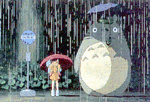 Princess Mononoke again through the course, and this time around, I was able to fully appreciate
the beauty and splendor of the work. I finally understood why it was regarded so highly. And as
grand as Miyazaki's works are, many of them are also readily accessible by children. We saw one of
his children films, My Neighbor Totoro, which presented childhood in a innocent, pure manner.
Children would be able to enjoy it for its simplicity of exhibition, as would adults who would be
able to see the depth and feeling of the film. At any rate, Miyazaki's films can be regarded as
a "higher" level of Japanese animation.
Princess Mononoke again through the course, and this time around, I was able to fully appreciate
the beauty and splendor of the work. I finally understood why it was regarded so highly. And as
grand as Miyazaki's works are, many of them are also readily accessible by children. We saw one of
his children films, My Neighbor Totoro, which presented childhood in a innocent, pure manner.
Children would be able to enjoy it for its simplicity of exhibition, as would adults who would be
able to see the depth and feeling of the film. At any rate, Miyazaki's films can be regarded as
a "higher" level of Japanese animation.
Did you enjoy The Matrix? Did you find the sci-fi futuristic world presented in that
film the least bit interesting? Well, it turns out that Matrix drew heavily from the world of
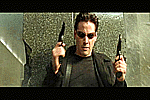 Japanese animation; in particular, the world of "cyberpunk." The term itself refers to a vision
of the future through a noir (or darker) perception. In this future, many times there are cyborgs
(humans with mechanical parts) and androids (machines with an anatomically human guise). These
Japanese animation; in particular, the world of "cyberpunk." The term itself refers to a vision
of the future through a noir (or darker) perception. In this future, many times there are cyborgs
(humans with mechanical parts) and androids (machines with an anatomically human guise). These
 concepts bring about some interesting discussions such as whether or not a machine that thinks
for itself can have a soul. Questions arise concerning what makes a human a human, and we are
able to look at our own selves in an introspective, thoughtful manner. The concept of humans
versus technology is also brought to the forefront by cyberpunk. We've seen the boom of the computer
and the internet in our lifetime; how will this trend continue in the future? With the commercial
success of The Matrix, that was so heavily influenced by anime, I think you can imagine how those
fans would also embrace anime, if only they were aware of it.
concepts bring about some interesting discussions such as whether or not a machine that thinks
for itself can have a soul. Questions arise concerning what makes a human a human, and we are
able to look at our own selves in an introspective, thoughtful manner. The concept of humans
versus technology is also brought to the forefront by cyberpunk. We've seen the boom of the computer
and the internet in our lifetime; how will this trend continue in the future? With the commercial
success of The Matrix, that was so heavily influenced by anime, I think you can imagine how those
fans would also embrace anime, if only they were aware of it.
The reasoning behind all the emphasis on technology can also be tied in with Japan's post
WWII economic boom. We are aware of how technology played an important role in Japanese exports
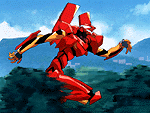 after the war (don't you have a Japanese brand stereo or video player somewhere in your house?)
As a result, the whole world along with Japan saw how wondrous technology could be. A genre of
anime which shows of bit of the human fetishization of technology is mecha, which essentially
means those big fighting robot anime, but it also encompasses the concept of battlesuits; both
providing on extension and expression of power by the individual involved. Concepts of human
power in regards to technology is always an underlying element in these futuristic anime. In
essence, futuristic Japanese animation took science fiction to a whole new level.
after the war (don't you have a Japanese brand stereo or video player somewhere in your house?)
As a result, the whole world along with Japan saw how wondrous technology could be. A genre of
anime which shows of bit of the human fetishization of technology is mecha, which essentially
means those big fighting robot anime, but it also encompasses the concept of battlesuits; both
providing on extension and expression of power by the individual involved. Concepts of human
power in regards to technology is always an underlying element in these futuristic anime. In
essence, futuristic Japanese animation took science fiction to a whole new level.
Yes, there is sex in some anime. And yes, we watched some erotic anime in the course.
 But the question of whether sexual-themed entertainment is right or wrong was a moot point. The
way in which we approached this particular genre of anime was to realize how these particular
works would actually bring in concepts beyond that of a simple physical act. In other words,
there would be much more depth in a most erotic anime, than in pornographic films in the US or
elsewhere. The concepts of the erotic were also an important part of historic Japanese culture.
Even back in the 1100's there was a lengthy novel written called The Tale of Genji, which told
of the exploits of courtesans of the time. Amorous acts such as voyeurism were regarded as socially
acceptable ways in which courting was done. In the 1700's, there were also famous woodblock artists
But the question of whether sexual-themed entertainment is right or wrong was a moot point. The
way in which we approached this particular genre of anime was to realize how these particular
works would actually bring in concepts beyond that of a simple physical act. In other words,
there would be much more depth in a most erotic anime, than in pornographic films in the US or
elsewhere. The concepts of the erotic were also an important part of historic Japanese culture.
Even back in the 1100's there was a lengthy novel written called The Tale of Genji, which told
of the exploits of courtesans of the time. Amorous acts such as voyeurism were regarded as socially
acceptable ways in which courting was done. In the 1700's, there were also famous woodblock artists
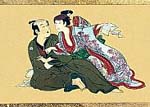 who created, among other works, erotic prints. Now while the influence of these concepts was
made obvious in the course, we were always reminded that we were in fact dealing with another culture. If a culture is less inhibited about certain sexual topics, then as a student learning about that culture, we should always respect these aspects. That being said, however, erotic anime is still only fraction of what anime is overall.
who created, among other works, erotic prints. Now while the influence of these concepts was
made obvious in the course, we were always reminded that we were in fact dealing with another culture. If a culture is less inhibited about certain sexual topics, then as a student learning about that culture, we should always respect these aspects. That being said, however, erotic anime is still only fraction of what anime is overall.
The concept of the end of the world is encompassed in a particular genre of anime, which
lends itself heavily to many universal themes, is apocalyptic anime. These anime usually detail
an event which literally destroys the world as it originally was. The basis of these anime delves
from the apocalyptic event which only the Japanese people have experienced in the history of this
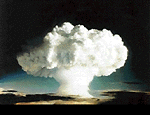 world: the atomic bomb. Such a concept is beyond the grasp of any other persons on this planet;
can you even begin to imagine what such an event would be like? Sure, we know about the facts
of the destruction, but we are never going to feel the same wrenching emotions that must have
been felt, especially by those who were not instantly killed. The image of the atomic bomb has
become a permanent fixture in Japanese history, and by exploring the concepts surrounding these
events, the Japanese are better able to understand themselves. Apocalyptic anime provides a
opportune ground for examining these concepts, as it allows for a freedom of expression which
live-action cinema cannot. It also allows for in-depth exploration of religious concepts such
as the final judgment of humankind by God, and all of our fears, needs and desires. One of the
anime we saw in the course was one called Neon Genesis Evangelion, which was so psychologically
involving, our professor commented on many occasions that an entire course could be dedicated to it.
world: the atomic bomb. Such a concept is beyond the grasp of any other persons on this planet;
can you even begin to imagine what such an event would be like? Sure, we know about the facts
of the destruction, but we are never going to feel the same wrenching emotions that must have
been felt, especially by those who were not instantly killed. The image of the atomic bomb has
become a permanent fixture in Japanese history, and by exploring the concepts surrounding these
events, the Japanese are better able to understand themselves. Apocalyptic anime provides a
opportune ground for examining these concepts, as it allows for a freedom of expression which
live-action cinema cannot. It also allows for in-depth exploration of religious concepts such
as the final judgment of humankind by God, and all of our fears, needs and desires. One of the
anime we saw in the course was one called Neon Genesis Evangelion, which was so psychologically
involving, our professor commented on many occasions that an entire course could be dedicated to it.
So you see, as I did, there are so many more types of anime than just sex and violence,
and that by saying anime is simply all of one particular type, we would be making a quite narrow
generalization. So back to why the university would offer such a course? Well, I think you understand
why now. Anime is not something that can simply by categorized in a single thought; it is vastly
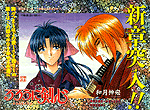 complex, and hence quite educationally valuable. You get to learn about a whole new culture,
through this medium. Of course, having me tell you all this may or may not be sufficient to change
your outlook. Seeing is believing, so I'd be happy to lend you various anime so you can see for
yourself; I guarantee that you'll understand what I'm talking about. Anyway, let's get back to
the party now ... those cheeses look great ..."
complex, and hence quite educationally valuable. You get to learn about a whole new culture,
through this medium. Of course, having me tell you all this may or may not be sufficient to change
your outlook. Seeing is believing, so I'd be happy to lend you various anime so you can see for
yourself; I guarantee that you'll understand what I'm talking about. Anyway, let's get back to
the party now ... those cheeses look great ..."
|
The Popularity of Rurouni Kenshin with a Female Audience (scanned in jpg format)
[ Page 1 ]
[ Page 2 ]
[ Page 3 ]
[ Page 4 ]
[ Page 5 ]
[ Page 6 ]
|
[ BACK TO MAIN ]
|